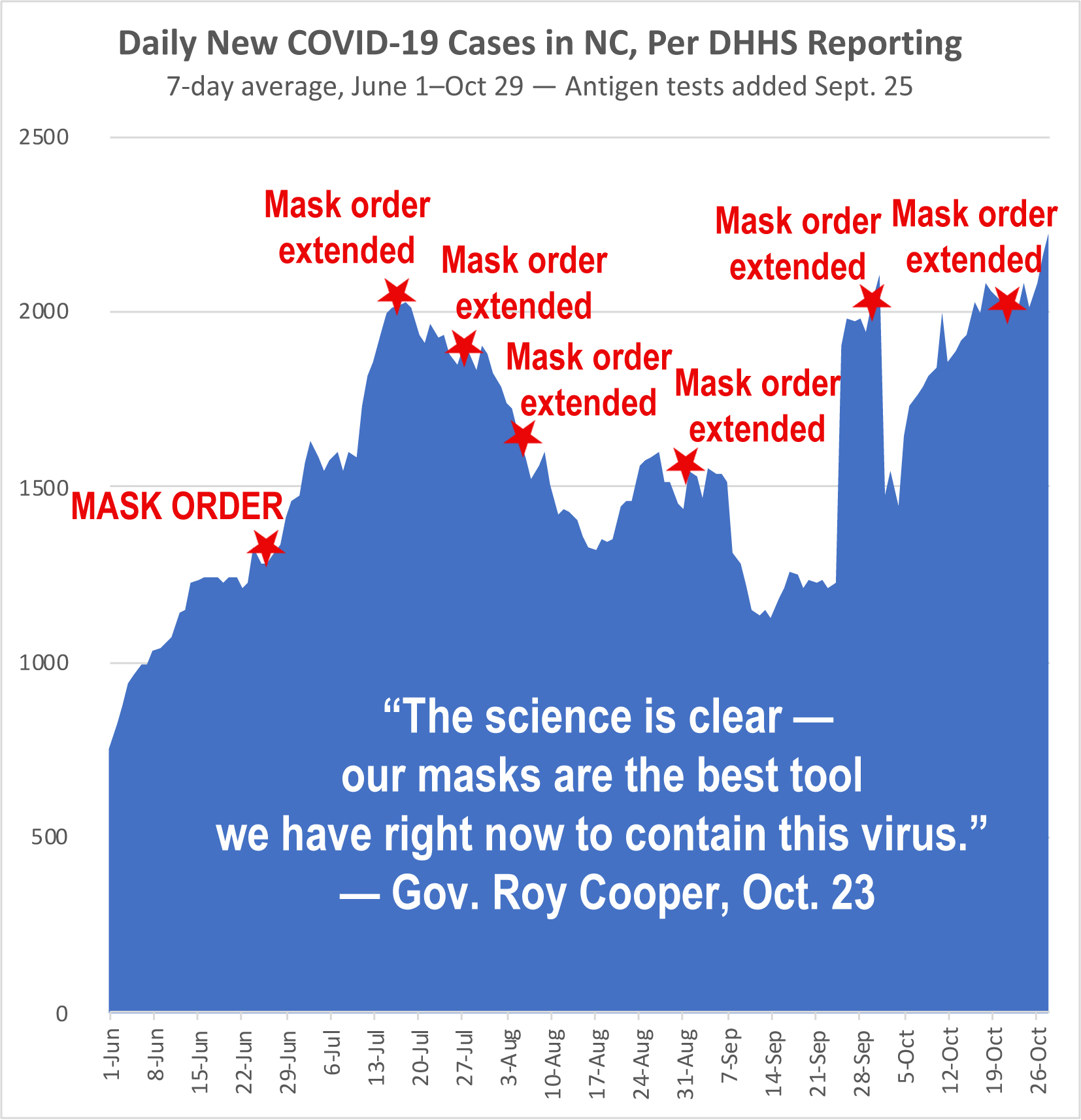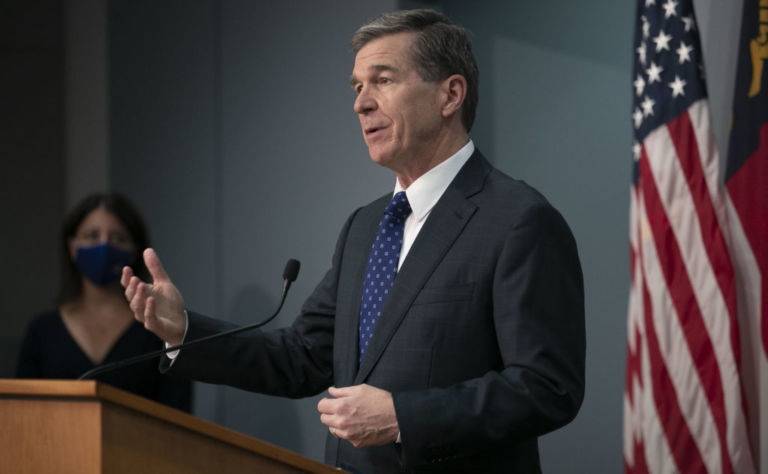For many weeks I have been producing contextualized looks at North Carolina’s COVID-19 numbers. Recently, I’ve started calling it the “NC Threat-Free Index.” Here’s why.
Round-the-clock virus coverage in media, authoritarian government restrictions against people and businesses, and questionable state health data have all contributed to a climate of fear and suspicion far out of scope with what the virus warrants and without any regard to severe and mounting unintended consequences in other aspects of people’s lives.
Media frantically report every daily case number without any context. Gov. Roy Cooper and state health bureaucrat Mandy Cohen (when not heaping credit on themselves for the state’s low case count) blame case increases on people not wearing masks and getting lazy about social distancing. At the end of October they even sent letters to county officials telling them they ought to crank up their COVID restrictions and enlist the locals in snitching on noncompliant neighbors.
Cooper has still not even brought the state into full Phase 2 yet. If those letters to county officials are any indication of where his inclinations lie, North Carolinians are more likely to face harsher restrictions and personal sanctions because of this:

Things are also getting sillier. News services are running stories on how to approach people who aren’t wearing masks. Health officials and magazines are publishing materials about wearing masks when you’re kissing, or even after you’ve rounded second base and are heading home. Cohen actually urged kids planning to go trick-or-treating to “Wear a mask under your Halloween mask.”
Governors and public health officials are trying to cancel your Thanksgiving, and they’re even eyeing Christmas like stop-motion villains in every Claymation special ever. Cooper recently praised someone for canceling the family Thanksgiving tradition by saying it was “because they loved and cared about each other.”
People are left with the impression that we’re surrounded by a contagion that’s far more widespread and deadly than it really is. Among other things, it makes them extremely vexed when someone says something like “far more widespread and deadly than it really is,” as if seeking to quantify how infectious and deadly this virus is constitutes a kind of COVID blasphemy.
It also makes them wear masks driving alone in their own cars, when they’re in their own homes, or when they’re outside walking, running, or biking. I’ve even heard of a man hiking the Appalachian Trail so swaddled in personal protection equipment he looked like an extra in “Outbreak,” and in a rare momentary encounter with another hiker, he jumped off the path and cowered in the underbrush.
Normally, government officials and media consider it their public duty to calm people and tamp down unhealthy, irrational fears. Not this year. Apparently, part of their vision of a “new normal” involves terrified reporters terrifying viewers and terrific outrage at people who aren’t sufficiently terrified.
I prefer my media-fed mass hysterias narrated by Orson Welles.
All fear, no context
It is in this crucible of inflamed amygdalas that I realized that people aren’t getting numbers in context, and even after several months of it they haven’t realized that it’s still rare for someone to get a laboratory-confirmed case. And about that term, “laboratory-confirmed case” — the labs here are going well beyond the research-supported threshold for determining a positive result. Most of the cases might not have been actual infections. And because of how the state conflates “with COVID” and “because of COVID,” the actual numbers of COVID-caused hospitalizations and deaths are also unclear.
The point being, after eight months of this, even with testing thresholds geared for false positives, most of the people you know have not had a lab-confirmed case of COVID-19. But I’ll bet you know several who have suffered economic impacts, loss of jobs, loss of income, anxiety or worse because of COVID-19. I certainly do.
Strangely, over time, instead of people realizing things cannot be as dire as they appeared back in March, they seem more afraid. There’s a twist to it now. People seem to view contracting an infection as a consequence of someone’s COVID sin. You didn’t social-distance enough. You shouldn’t have gone to that restaurant. They’re not wearing masks. “We too often let our guard down,” assumed Cooper. They shouldn’t be holding that rally. They shouldn’t be praising Jesus.
It comes down to this presumed commandment: We shouldn’t be doing anything we enjoy that brings people together to laugh, talk, cheer, and smile. Sit home, fear the virus, and obsess about politics — the one activity that is safe.
If you were to walk into any store in North Carolina right now, dine in any restaurant, or even, Roy forbid, have a drink with friends, how many fellow patrons there could be infected and capable of infecting you right now? How high is that number in your mind?
Cases are going up, you know. We’re closing in on three hundred thousand cases soon. Media will throw that number a virtual panic-parade.
But did you know that two weeks later, we’ll be closing in on three hundred thousand recoveries? Did you also think about how large North Carolina’s population is? Official estimates are it was 10.63 million people in July.
The NC Threat-Free Index for the first week of November
What does all that mean? That’s what my NC Threat-Free Index shows. It’s a weekly update of how virus-free your fellow North Carolinians are.
This is the NC Threat-Free Index for the week of November 2:
- As of Nov. 2, there are 246,318 North Carolinians presumed to be recovered from COVID-19
- Less than one-tenth (9.8%) of NC’s total case count constantly trumpeted by the Cooper administration and media are active cases (note: a case of COVID isn’t a permanent infection, and only someone with an active case of the virus can conceivably transmit it to you)
- Active cases represent just 0.26% (over two-tenths of one percent) of NC’s population (note: active cases are lab-confirmed cases of COVID-19 minus recoveries and deaths)
- Nearly nine out of every ten (88.6%) of NC’s total cases are recovered, meaning they are no longer infectious
- Only 0.04% of people in NC have died with COVID-19 (regardless of the actual cause of death)
- 97.3% of people in NC have never had a lab-confirmed case of COVID-19 (note: this proportion will always decline, but we have been living with this virus since February, as far as testing is concerned)
- All considered, 99.7% of people in NC pose no threat of passing along COVID-19 to anyone — a virus most have never had and the rest have recovered from (note: this proportion will fluctuate based on the relative growth in lab-confirmed cases vs. recoveries) (side note: this proportion is likely understated because NC’s population has continued to grow since July)
Is this to say we should not respect the virus? Of course not. It is not to downplay the seriousness of COVID-19 or the lives lost because of it. But it is also not to make out as if it is the plague.
The Great Barrington Declaration offers a sensible way forward, the way societies till now have regarded such contagions. Created by three top health experts — Harvard University professor of medicine Dr. Martin Kulldorff, Oxford University epidemiologist Dr. Sunetra Gupta, and Stanford University Medical School professor Dr. Jay Bhattacharya — and signed by tens of thousands of medical and scientific professionals and health practitioners, the Great Barrington Declaration states:
Those who are not vulnerable should immediately be allowed to resume life as normal. Simple hygiene measures, such as hand washing and staying home when sick, should be practiced by everyone to reduce the herd immunity threshold. Schools and universities should be open for in-person teaching. Extracurricular activities, such as sports, should be resumed. Young low-risk adults should work normally, rather than from home. Restaurants and other businesses should open. Arts, music, sport, and other cultural activities should resume. People who are more at risk may participate if they wish, while society as a whole enjoys the protection conferred upon the vulnerable by those who have built up herd immunity. [Emphasis added]
It is clearly the better way.


